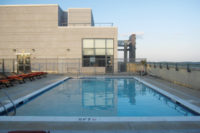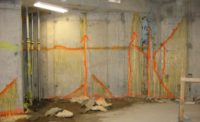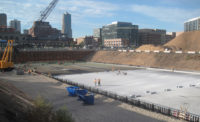Many blind-side below-grade waterproofing systems include resistance to lateral water migration between the membrane and concrete as part of the manufacturer’s design concept. Without lateral migration resistance, water at a membrane breach may travel to remote cracks and penetrations in the foundation structure and into occupied space (Figure 1), thereby making the leakage source more difficult to isolate and repair. Most conventional blind-side below-grade waterproofing systems either rely on short-term or long-term confining pressure, in part depending on whether the technology includes an adhesive-based bond (e.g., single-ply sheets such as unreinforced HDPE or reinforced thermoplastic products) or swelling-based materials (e.g., sodium bentonite) as part of the mechanism for lateral migration resistance.
Contemporary waterproofing industry wisdom holds that bond is necessary for sheet membranes, and confining pressure is necessary for sodium bentonite membranes to perform as intended (i.e., limit leakage risk given the high likelihood of some membrane damage during construction). These principles have merit in a general sense, but there are few industry sources that define appropriate or measurable performance requirements for bond or confining pressure to avoid the risks of lateral water migration. Given the apparent importance of lateral water migration resistance as a performance attribute, below-grade waterproofing stakeholders (i.e., manufacturers, designers/consultants, installers, building owners) would benefit from the following summary and proposed evaluation tools related to lateral-migration-specific topics:
· Hydrostatic pressure as one component of the pressures exerted on waterproofing membranes, and definitions for the other components.
· The type(s) of confining pressures required for different types of blind-side below-grade membranes, and how they relate to lateral migration resistance.
· The relationship between waterproofing bond to concrete and lateral migration resistance for both sodium bentonite and adhered sheet membranes.
· Standardized test methods to compare lateral migration performance for different types of membranes, especially at different confining pressures, in both adhesive-based and swelling-based assemblies.
In this article, the authors describe their understanding of the existing “wisdom” and some of the opportunities for waterproofing-industry knowledge advancement.
Confining Pressure Types
The waterproofing industry has a general understanding of the concept of confining pressure as it relates to membrane performance, but discussion related to its nature, source of the forces, and their influence on waterproofing appears incomplete. The authors find that looking at pressures individually facilitates their understanding and consulting approach to confining pressure, as well as highlights the value of testing lateral water migration in these waterproofing systems.
Hydrostatic Pressure
The hydrostatic pressure on the waterproofing membrane is a result of the force of gravity acting on water adjacent to the membrane. Assuming saturated soil or open water (e.g., in a filled drainage composite), the water exerts a pressure on below-grade walls (normal to their surface) equal to the unit weight of water (62.4 pcf) times the vertical distance below the elevation of groundwater at atmospheric pressure (this elevation is known as the phreatic surface, but is commonly referred to as the water table). The force increases as depth below the water table increases. For example, 5 feet below the water table, the waterproofing membrane will experience approximately 312 psf (62.4 pcf x 5 feet = 312 psf) of hydrostatic pressure (Figure 2). Hydrostatic pressure is a variable confining pressure and since the amount of hydrostatic pressure at any given point will change as water tables fluctuate (e.g., seasonally), hydrostatic pressure near the water table elevation cannot always be relied upon as a long-term confining pressure as it will occasionally drop to zero at some locations on a structure. In addition, at a breach in the membrane, hydrostatic pressure in the vicinity of the breach will act on both sides of the membrane, resulting in reduced confining pressure.
Comprehensively representing hydrostatic pressure graphically can be complex. For practical purposes, and in the context of the lateral water migration discussion, Figure 2 illustrates the fundamental concept of the increasing depth below the water table and the increasing hydrostatic pressure. Figure 2 assumes that the shoring system (represented as wood lagging) completely resists lateral soil pressure and water from the soil penetrates the shoring system or fills the drainage composite adjacent to the waterproofing membrane.
Other Confining Pressures
We also need to explore the other confining pressures on the membrane, both short- and long-term. We define the key pressures individually, and categorize their duration (short-term versus long-term) below:
· Confining pressure from construction (short-term):
o Fluid concrete placed against the blind-side waterproofing membrane exerts a lateral pressure, also known as contact pressure (Figure 3). The authors assume this pressure reduces to zero as the concrete hardens (i.e., the structure stiffens), but this assumption is beyond the scope of this paper and worth further exploration. Additionally, this pressure is hydrostatic by definition, but from the standpoint of minimizing confusion between fluid concrete pressure and hydrostatic pressure from saturated soil or open water below the water table (discussed above), the authors choose to categorize it as a short-term confining pressure.
o Concrete swells as the gel formed by the addition of water to Portland cement produces a volumetric expansion of the concrete during the curing process.
o Membranes that swell create additional pressure between the hardening concrete and the support of excavation, as moisture from the concrete and/or adjacent materials are absorbed by the membrane
· Confining pressure from soil or soil pressure bearing against the waterproofing and its concrete substrate (long-term): For practical purposes, we consider these pressures to be exerted by materials in permanent surface contact with the waterproofing membrane (i.e., deflection of the concrete and support of excavation, consolidation of the soil, and other long-term pressure changes are simplified in our consideration herein).
These “other” confining pressures are often the primary sources of lateral force on waterproofing during construction because temporary dewatering will almost always temporarily relieve hydrostatic pressure.
Confining Pressure and Bond—Discussion in Industry Literature and Standards
Confining Pressure Literature
As illustrated in the following excerpts from a waterproofing industry design treatise, the perception of confining pressure is often limited to its role with sodium bentonite membranes. For example, The Manual of Below-Grade Waterproofing Systems (Henshell, Justin, 2005) notes in Chapter 12 – Bentonite Waterproofing.
· “To perform at peak waterproofing efficiency, the bentonite must be compressed under continuous pressure…”
· “The need to maintain minimum confinement pressure is a prime preliminary design criterion for bentonite waterproofing systems.”
· “Remember the need for continuous confinement pressure to maintain a compressive stress on a bentonite system.”
The understanding expressed above is that swelling-based membranes (bentonite) require a minimum confining pressure, but that minimum is not defined in this treatise for the category of bentonite membranes. Additionally, while an excellent reference, Henshell does not fully explore how lateral water migration resistance of waterproofing increases/decreases with confining pressure.
Waterproofing Bond Literature
Waterproofing industry literature and standards acknowledge that bond is pertinent to both swelling-based and adhesive-based blind-side membranes. Principles of Design and Installation of Below-Grade and Building Deck Waterproofing in 2010
(Rutila, Dean, et. al. 2010), notes:· Blind-Side (Wall and Below Slab)—Sodium Bentonite and Sodium Bentonite Polymer Systems. “…supplied as rolled goods in fabric carriers obtain sufficient mechanical anchorage when plastic concrete is placed on or against the fabrics to attach the membrane to the concrete…”
· Unreinforced High Density Polyethylene. “…this system relies on adhesive bond to the concrete…”
· Blind-Side (Wall and Below Slab)—Unreinforced High Density Polyethylene with Factory Applied Pressure Sensitive Adhesive. “…adheres well to cured concrete when 75 mm or more of wet, plastic concrete are placed against the adhesive.”
Also, for adhesive-based membranes, ASTM D7832 Standard Guide for Performance Attributes of Waterproofing Membranes Applied to Below-Grade Walls/Vertical Surfaces (Enclosing Interior Spaces) notes:
· Waterproofing Membrane Performance Attributes 6.1. “The following performance attributes are required for a waterproofing membrane:
o 6.1.1 – Perform under hydrostatic pressure…
o …6.1.10 – Adhere tenaciously to the substrate.”
· Design of Waterproofing Assembly 7.2. “The membrane selected for use shall pass the tests outlined in Table 1” [including:]
o …C. Adhesion to Substrate (except for Grade I – Class 2, partially adhered sheet): Test Method D7234, Test Method D903
Finally, The Manual of Below-Grade Waterproofing Systems briefly touches upon the relationship between waterproofing bond to concrete and lateral migration resistance by noting:
• Chapter 4 – Waterproofing—Blind Side Waterproofing. “The problem with some sheet systems is the lack of positive adhesion with the concrete. Positive adhesion is advantageous because it facilitates leak detection by limiting the migration of leakwater between the sheet and the concrete.”
The notion that bond is pertinent to swelling-based membranes and important for
adhesive-based membranes makes sense. Given the apparent relationship between waterproofing bond to concrete and lateral migration performance, both for swelling-based and adhesive-based membranes, the authors propose that the waterproofing industry will benefit from a closer exploration of the relationship between confining pressure, bond and lateral migration resistance through testing and quantification.
Opportunity for New Industry Standardization
There is currently no standardized test method to evaluate a blind-side waterproofing membrane’s resistance to lateral water migration. Some manufacturers report lateral migration testing using a modified version of ASTM D5385 Standard Test Method for Hydrostatic Pressure Resistance of Waterproofing Membranes at 100 psi hydrostatic pressure, in the context of lateral migration performance. For background, the unmodified ASTM D5385 method includes application of the waterproofing membrane (in a positive-side configuration) to a concrete patio block with a kerf cut on the opposite side of the block along the center in one direction. The membrane is placed with a membrane seam perpendicular to the kerf cut. After membrane application, the block is tapped with a hammer to induce a substrate crack along the kerf, which will cross the membrane seam. The cracked assembly is inserted into a gasketed chamber filled with water, and hydrostatic pressure is incrementally increased (over approximately 8 hours) up to 100 psi while for the observer looks for leaks through the crack in the backside of the concrete block.
Modifying the ASTM D5385 test for the purposes of assessing lateral migration in blind-side membranes is conceptually sound, but the test creates a high pressure (up to 100 psi, or equivalent to 230 feet of water head) that may limit lateral migration. The authors propose that the test as we understand it is reported, does not address many of the issues related to confining pressure and bond. Many waterproofing applications are only a few stories below-grade and are likely to have much lower confining pressures (the pressure created by swelling-based membranes is not well described in literature but is likely lower). The relationship between hydrostatic pressure and lateral migration resistance is apparently unexplored by this modified ASTM test, but it may be shown that the high hydrostatic pressure imparts a gasketing effect on the membrane. Performance at low confining pressures in the absence of hydrostatic pressure is potentially more dependent on the bond of waterproofing, however achieved, compared to any confining pressure. Some waterproofing manufacturers appear to recognize this demand by requiring, albeit anecdotally, a minimum confining pressure. But even with this acknowledgement, there is no in situ or laboratory test to confirm that the estimated confining pressures actually exits.
Proposed Standardized Test Method
Given its apparently accepted importance as a performance attribute, especially with blind-side waterproofing membranes, lateral water migration warrants dedicated standardized test methods. In addition to allowing comparative assessments between different membrane types, such tests would provide particular value if they addressed the following unanswered questions:
• What is the low limit of serviceable confining pressure for each type of blind-side membrane? And what type or types of confining pressure governs at the low limit?
• How well do blind-side membranes resist lateral migration at just above their low limit of confining pressure (i.e., quantifiable testing)? Does the membrane resist lateral migration at incrementally higher confining pressures?
• How well do blind-side membranes resist lateral migration for longer durations (i.e., several weeks) as compared to the ASTM 5385 duration of several hours?
Summary
The blind-side waterproofing application method represents a significantly large and particularly challenging segment of the below-grade waterproofing industry. Further, lateral water migration resistance is a critical attribute of waterproofing that warrants deeper exploration than current industry guidance and standards provide. Production of a new ASTM standard that quantifies performance of waterproofing at a range of confining pressures would make waterproofing types readily comparable. Manufacturers and installers will benefit from such information or new standards by better understanding the appropriate service environments for specific membrane types. Designers/consultants will benefit by the ability of the information or standard to inform thoughtful specifications and installation details for specific membrane types (Figure 4). And building owners will benefit from the opportunity of better understanding the probability of success for specific membrane types. The authors look forward to supporting the waterproofing industry in this endeavor.
References
1. Henshell, J., The Manual of Below-Grade Waterproofing Systems, C.W. Griffin Ed., Wiley, New York, 2016
2. Rutila, D. A., Klein, K. A., and Normandeau, M. J., “Principles of Design and Installation of Below-Grade and Building Deck Waterproofing in 2010,” Journal of ASTM International, Vol. 9, No. 1, ASTM International, West Conshohocken, PA, 2011
3. NRCA 2005, The NRCA Waterproofing Manual, National Roofing Contractors Association, Rosemont, IL, 2005
4. ASTM Standard D5385, 1993 (2014), “Standard Test Method for Hydrostatic Pressure Resistance of Waterproofing Membranes,” ASTM International, West Conshohocken, PA, http://www.astm.org.
5. ASTM Standard D7832, 2014, “Standard Guide for Performance Attributes of Waterproofing Membranes Applied to Below-Grade Walls / Vertical Surfaces (Enclosing Interior Spaces),” ASTM International, West Conshohocken, PA, http://www.astm.org.
6. Klein, K. A., “Proactive Waterproofing,” Construct. Spec., March, 2007, pp 36-43.
7. Klein, K. A. and Gibbons, D. G., “Don’t Get Blindsided: Techniques for Blind-Side Waterproofing,” Construct. Spec., April 2001, pp 35-42.










